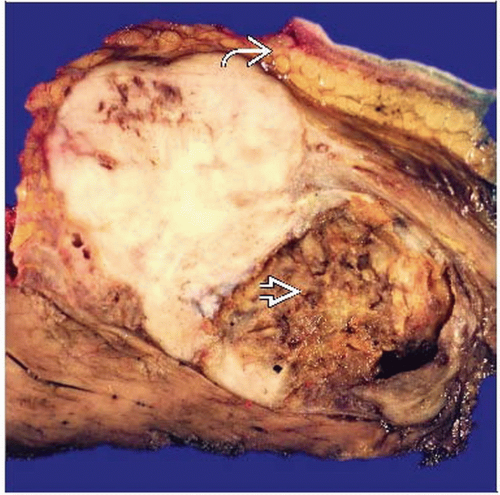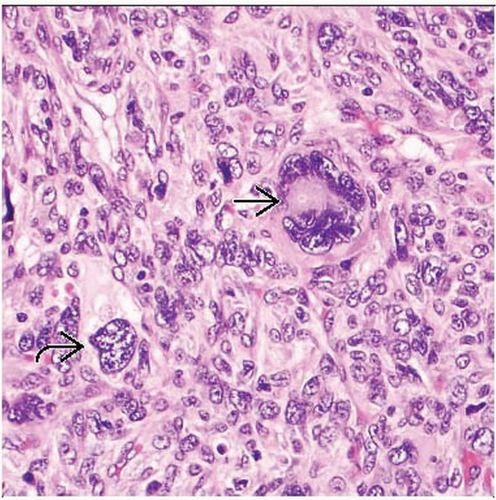Undifferentiated Pleomorphic Sarcoma
Khin Thway, BSc, MBBS, FRCPath
Key Facts
Terminology
Anaplastic sarcoma composed of pleomorphic spindle and polygonal cells
No other definable differentiation, other than fibroblastic or myofibroblastic
Etiology/Pathogenesis
Small proportion of cases occur post irradiation or secondary to chronic ulceration/scarring
Clinical Issues
Most common adult soft tissue sarcoma
Most frequent in deep soft tissue of extremities
Usually high-grade tumors
Pulmonary metastases in up to 1/2 of cases
Older adults
Macroscopic Features
Thorough sampling required to demonstrate any possible lines of differentiation
Heterogeneous cut surface
Necrosis and hemorrhage
Microscopic Pathology
Diagnosis of exclusion
Morphology shared by many tumors of different lineages
Storiform pattern, loose fascicles or sheets
Markedly atypical cells
Abundant mitoses and necrosis
No discernible microscopic features of differentiation
Immunohistochemical panel required to exclude tumors with specific differentiation
TERMINOLOGY
Synonyms
Pleomorphic sarcoma
Undifferentiated high-grade sarcoma
Malignant fibrous histiocytoma (MFH)
Definitions
Anaplastic sarcoma composed of pleomorphic spindle and polygonal cells
No other definable differentiation, other than fibroblastic or myofibroblastic
Morphologic pattern shared by poorly differentiated or anaplastic tumors of different lineages
Diagnosis of pleomorphic sarcoma is therefore one of exclusion
ETIOLOGY/PATHOGENESIS
Environmental Exposure
Can occur at site of previous irradiation
Rarely secondary to chronic ulceration or scarring
CLINICAL ISSUES
Epidemiology
Incidence
Most common adult soft tissue sarcoma
Incidence increases with age
Age
Older adults
Very rare in adolescents and young adults
Gender
Slight male predominance
Site
Deep soft tissue
Most in extremities
Lower limb > upper limb
May also arise on trunk
Most intraabdominal examples represent dedifferentiated liposarcoma
Smaller numbers occur superficially
Presentation
Enlarging mass
Painful or painless
Small proportion of patients have metastases at presentation
Prognosis
Usually high-grade tumors
Local recurrence in up to 1/3 of cases
Pulmonary metastases in up to 1/2 of cases
Superficial tumors have better prognosis than deep ones
Myoid differentiation is prognostically adverse, with earlier metastasis
Applies whether differentiation is morphologic (leiomyosarcoma, myofibrosarcoma, rhabdomyosarcoma) or only immunohistochemical (actin, desmin)
Dedifferentiated liposarcoma has comparatively low metastatic rate
MACROSCOPIC FEATURES









